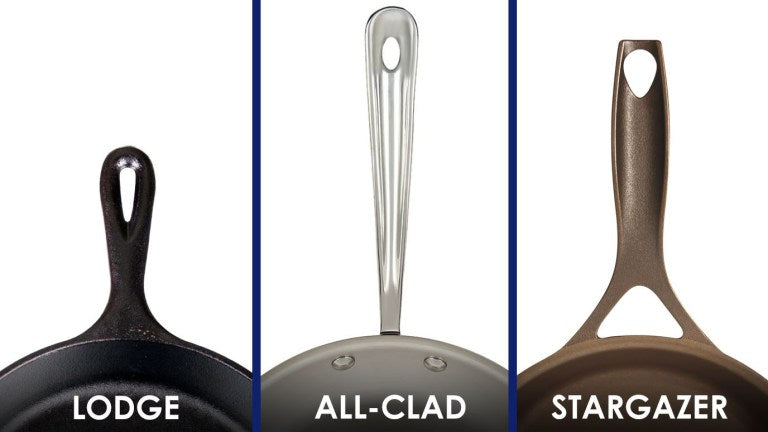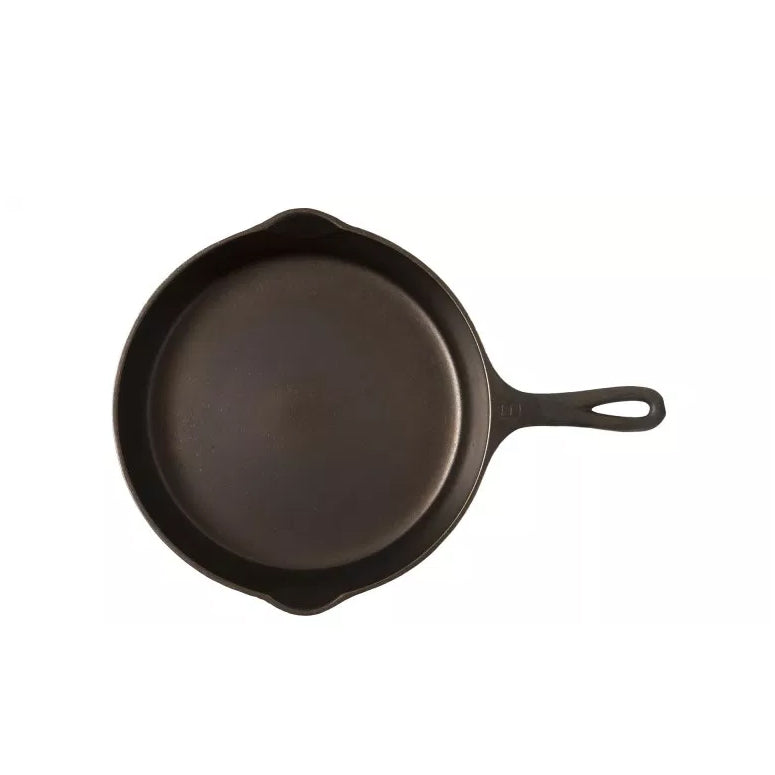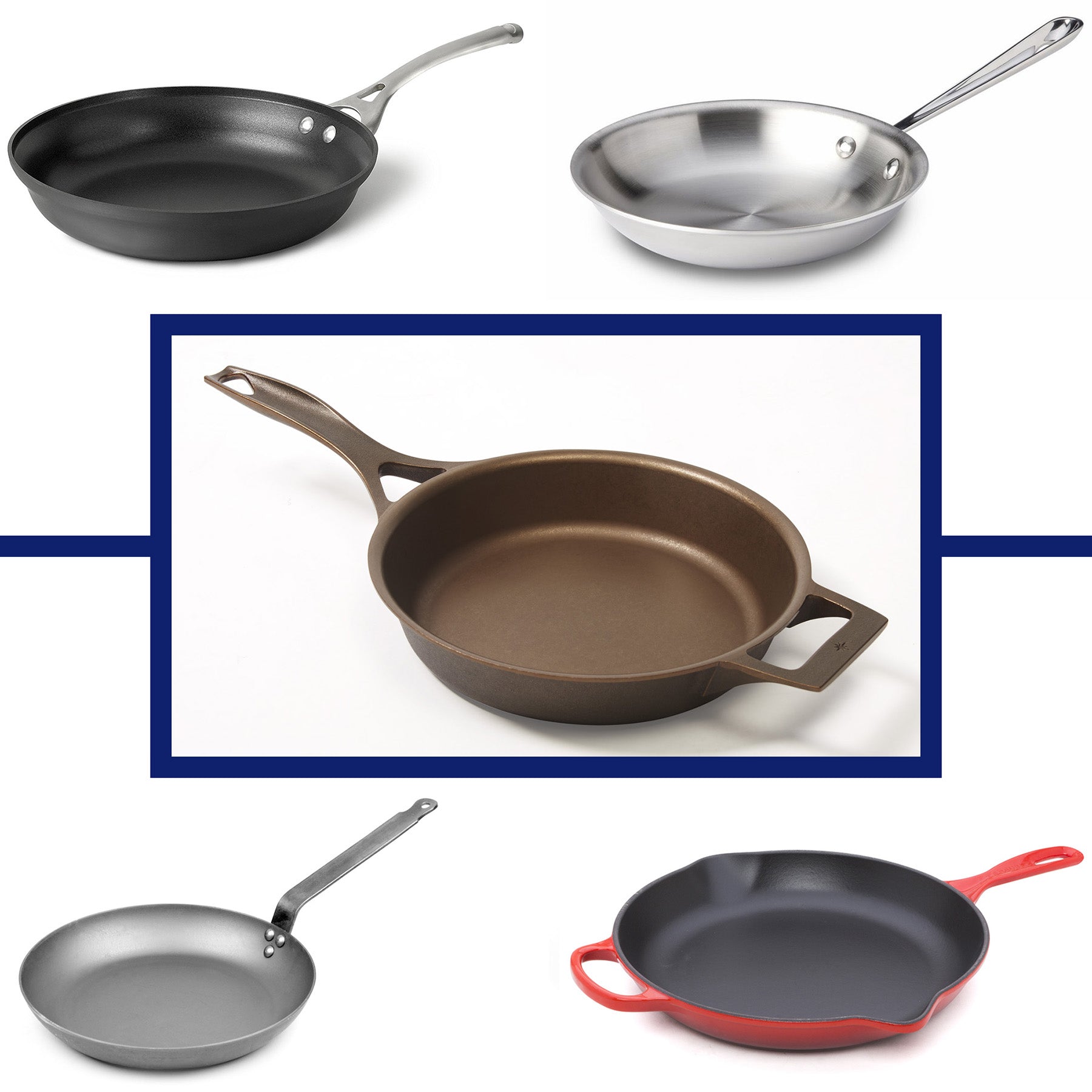One of the things we all love about vintage cast iron cookware is the lighter weight. It’s easier to maneuver on the stove, easier to lift and easier to pour from. Given that most people’s first complaint about cast iron is that it’s too heavy, it seems like the goal should be to make a skillet as light as possible. But it’s just not that simple.
Putting aside the composition of the material for now–we can discuss that in another post–the weight of a cast iron skillet comes down to two factors: the thickness of the material and the design of the handle. It’s really just those two things.
MATERIAL THICKNESS
Let’s talk about thickness first. Take a look at the vintage cast iron skillet pictured below.This is a Griswold size #8 and it measures about 10.5 inches in diameter. This example is from the large block logo era, and judging from the smooth bottom with no heat ring, it was probably produced sometime in the 1930s. I wanted to look at this skillet in particular because it is one of the lightest skillets I’ve seen in this size.

I checked skillets from all different manufacturers and different time periods and this one is unusually lightweight. It weighs only 3.77 pounds. Most Griswold skillets this size, from this era, are just over 4 pounds. Given how much of the manufacturing process back then was done by hand, they varied quite a bit from one skillet to another.
So what does that tell us? It is likely that this skillet must have been ground thinner after casting than the other skillets cast from the same pattern. So I measured it, and this one is about 0.105 inches thick at the base. It’s even thinner along the side wall, only 0.069 inches in some spots.
DURABILITY
So you might be thinking, that’s great, why don’t we machine them that thin every time? The answer is that there’s a trade-off. A cast iron skillet like this, despite its reputation, is surprisingly fragile. If I dropped it on a hard floor, there’s a good chance it would crack. I’ve bought a couple of vintage skillets like this one online, only to have them crack during shipping. It survives a hundred years and one drop totals it. On top that, metal this thin has trouble holding its shape, so rapid changes in temperature, known as thermal shock, are more likely to warp the surface. The vintage market is just littered with warped skillets. Collectors call them spinners because they don’t sit flat.
COOKING PERFORMANCE
Aside from the durability issues, we also need to look at cooking performance. Since heat capacity is a function of mass, a thinner, lighter skillet won’t retain heat as effectively as a heavier one. It also doesn’t distribute the heat as well, so you can expect a skillet this thin to have more hot spots, which just means that some areas are going to be noticeably hotter than others, causing some foods to cook unevenly.
On the other hand, a thicker, heavier skillet comes with its own disadvantages. Let’s look at this modern Lodge skillet, pictured below. It’s a popular option on the market. It’s about the same size as that Griswold, but it weighs 5.63 pounds, which is 49% heavier. Now we can attribute some of that to the addition of a helper handle, but most of that weight is in the thickness of the material. This particular skillet is 0.164 inches thick at the base, about 56% thicker than the Griswold.

A cast iron skillet this thick will have fewer hot spots, and it’ll retain heat very well, but it also needs more energy to reach a usable temperature in the first place. You’re going to have to preheat it longer, and in the event that it gets too hot, and starts to burn your food, it’s going to be more difficult to bring it back down again. In other words, this skillet won’t be as responsive to temperature changes that you, the cook, make at the heat source. There are also the obvious drawbacks, like how it’s more difficult to lift–particularly with this short handle–but we’ll get to that in a minute.
When it comes to the ideal weight for a cast iron skillet, there is no one right answer and it’s a question of compromise and finding that sweet spot in the middle. When we were designing our Stargazer skillet, we tested some vintage skillets and modern cast iron skillets in a range of thicknesses and really focused on cooking performance. It’s great if the skillet is easy to lift, but it’s more important that it cooks well. We found that the ideal thickness for a cast iron skillet is about an eighth of an inch, or 0.125 inches. It’s heavy enough to retain heat well, but not so heavy that it’s a struggle to lift and pour from.
At that thickness, for a skillet this size, you’re looking at 3.98 pounds for just the center area. So about 4 pounds, and the rest of the weight is in the handles.
HANDLE DESIGN
With that in mind, let’s talk about the handle design. Without getting too deep into the specifics of the curved shape and the thickness at different points, let’s just look at handle length. Most vintage skillets, as well as this modern Lodge skillet, have a handle that’s about 4.75 inches. It’s just big enough to fill my hand but not long enough that it provides any substantial leverage. So we looked at cookware in other materials for comparison.

A comparably-sized stainless steel skillet by All-Clad, shown in the image above, has a handle that measures in at 7.93 inches, about 67% longer than the Lodge skillet. It gives me a better grip and I can get much more leverage, but that extra handle material adds to the weight as well. So the question is: How much weight do you want to add to the skillet to get that leverage? Well we decided that 7.93 inches was overkill, and something closer to 7 would be more practical. We ended up with a handle that’s 7.13 inches including the fork. It’s curved and tapered towards the edges to reduce the thickness, and this handle by itself weighs 0.84 pounds. Could we make it lighter? Yes, but it would have to be shorter or thinner, which means more difficult to lift or less durable.
Let’s move on to the helper handle. Vintage skillets this size don’t have one. At the time, helper handles were only on skillets size #12 and up, which is over 13 inches in diameter. More recently, helper handles are included on smaller sizes as well. You can see two modern versions of them here. The Finex skillet has a tab handle (no opening), and the Lodge skillet has a loop handle, both shown in the image below.

The tab handles are the lightest option because they add the least amount of material, but we’ve found them difficult to grip, particularly with a pot holder. The loop handles are easier, especially if there’s enough clearance to get your fingers through. Again, comparing to other cookware for reference, cast iron is pretty stingy when it comes to the size of the helper handle. So we ended up with a design that’s easy to hold, even with a pot holder, and weighs only 0.38 pounds. The added convenience is well worth such a small addition to the weight, in our opinion.
When we developed our Stargazer 10.5-inch skillet, we put a lot of thought into how much it should weigh. The thickness of cast iron cookware is an important consideration and I hope this post shed some light on the subject. If you have any questions or feedback, give us a shout in the comments below. Thanks for reading! – Peter




Leave a comment
This site is protected by hCaptcha and the hCaptcha Privacy Policy and Terms of Service apply.